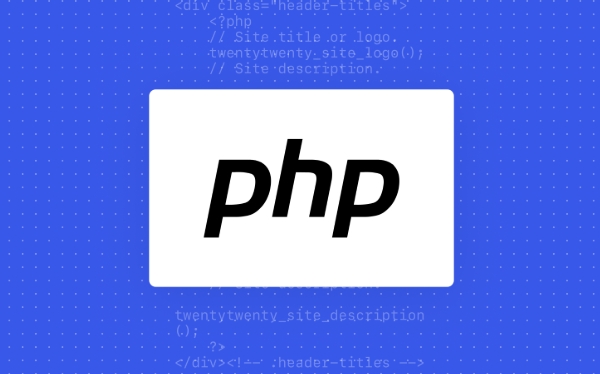To verify the date format in PHP, you must first use regular expression to verify the format, and then use checkdate() to confirm the validity. 1. Use regular expressions to match formats such as YYYY-MM-DD, DD/MM/YYYY or MM/DD/YYYY, but the pseudo-date cannot be recognized; 2. The recommended process is to first check the format with regex, and then use checkdate() to verify the actual legality; 3. The date formats in different regions are different, prompts or automatic identification should be provided if necessary; 4. Avoid excessive dependence on regularity, and keep it simple and more reliable.

Verifying date formats is a common requirement in PHP, especially when you need to make sure that the dates entered by the user meet a specific format. Using regular expressions (regex) is a flexible way, but it should be noted that it cannot completely replace the judgment of the authenticity of dates (for example, "pseudo-date" such as 2023-02-30 cannot be discovered through regex). However, for preliminary format verification, regex is a very practical tool.

Here are some common scenarios and corresponding suggestions:

Match YYYY-MM-DD format
This is one of the most common date formats and is suitable for many occasions such as databases, form submissions, etc.
You can use the following regular expression to match this format:
$pattern = '/^\d{4}-(0[1-9]|1[0-2])-(0[1-9]|[12]\d|3[01])$/';The meaning of this regex is:

-
\d{4}means four-digit year -
(0[1-9]|1[0-2])means that the month must be 01 to 12 -
(0[1-9]|[12]\d|3[01])means that the date range is reasonable
Usage example:
$date = '2023-12-31';
if (preg_match($pattern, $date)) {
echo "correct format";
} else {
echo "Format Error";
}Note: This rule only checks whether the format is legal and does not guarantee whether the actual date exists (for example, 2023-02-30 is considered to be the correct format, but it is actually not a legal date).
Verify other formats such as DD/MM/YYYY or MM/DD/YYYY
If you are facing international users, you may encounter different date formats. For example, the United Kingdom is used to using DD/MM/YYYY , while the United States is used to using MM/DD/YYYY .
Taking DD/MM/YYYY as an example, you can write it as:
$pattern = '/^(0[1-9]|[12]\d|3[01])\/(0[1-9]|1[0-2])\/\d{4}$/'; If the / delimiter is replaced - . , just replace / .
Note: This format is more suitable for display or regional processing. Before further logic, it is best to convert it to a standard format (such as
YYYY-MM-DD).
Stricter date validation
If you want not only to verify the format, but also to confirm whether the date is true (such as judging whether a leap year or a month or a month or a number of days), then regex alone is not enough. At this time, you should use the PHP built-in function checkdate() :
list($year, $month, $day) = exploit('-', $date);
if (checkdate($month, $day, $year)) {
echo "date valid";
} else {
echo "Invalid date";
}Although this method has a little more steps, it can truly verify the legitimacy of the date.
A few tips for practical use
- regex first and then checkdate : Usually the process is to use regex first to check whether the format matches, and then use
checkdate()to confirm the validity. - Consider user input habits : different formats in different regions, format prompts or automatic recognition if necessary.
- Avoid over-reliance on regularity : Although regex is powerful, it is prone to errors in complex scenarios, and it is more reliable to keep it simple, clear and reliable.
Basically that's it.
The above is the detailed content of php validate date format using regex. For more information, please follow other related articles on the PHP Chinese website!

Hot AI Tools

Undress AI Tool
Undress images for free

Undresser.AI Undress
AI-powered app for creating realistic nude photos

AI Clothes Remover
Online AI tool for removing clothes from photos.

Clothoff.io
AI clothes remover

Video Face Swap
Swap faces in any video effortlessly with our completely free AI face swap tool!

Hot Article

Hot Tools

Notepad++7.3.1
Easy-to-use and free code editor

SublimeText3 Chinese version
Chinese version, very easy to use

Zend Studio 13.0.1
Powerful PHP integrated development environment

Dreamweaver CS6
Visual web development tools

SublimeText3 Mac version
God-level code editing software (SublimeText3)

Hot Topics
 How do I implement authentication and authorization in PHP?
Jun 20, 2025 am 01:03 AM
How do I implement authentication and authorization in PHP?
Jun 20, 2025 am 01:03 AM
TosecurelyhandleauthenticationandauthorizationinPHP,followthesesteps:1.Alwayshashpasswordswithpassword_hash()andverifyusingpassword_verify(),usepreparedstatementstopreventSQLinjection,andstoreuserdatain$_SESSIONafterlogin.2.Implementrole-basedaccessc
 How do I stay up-to-date with the latest PHP developments and best practices?
Jun 23, 2025 am 12:56 AM
How do I stay up-to-date with the latest PHP developments and best practices?
Jun 23, 2025 am 12:56 AM
TostaycurrentwithPHPdevelopmentsandbestpractices,followkeynewssourceslikePHP.netandPHPWeekly,engagewithcommunitiesonforumsandconferences,keeptoolingupdatedandgraduallyadoptnewfeatures,andreadorcontributetoopensourceprojects.First,followreliablesource
 What is PHP, and why is it used for web development?
Jun 23, 2025 am 12:55 AM
What is PHP, and why is it used for web development?
Jun 23, 2025 am 12:55 AM
PHPbecamepopularforwebdevelopmentduetoitseaseoflearning,seamlessintegrationwithHTML,widespreadhostingsupport,andalargeecosystemincludingframeworkslikeLaravelandCMSplatformslikeWordPress.Itexcelsinhandlingformsubmissions,managingusersessions,interacti
 How to set PHP time zone?
Jun 25, 2025 am 01:00 AM
How to set PHP time zone?
Jun 25, 2025 am 01:00 AM
TosettherighttimezoneinPHP,usedate_default_timezone_set()functionatthestartofyourscriptwithavalididentifiersuchas'America/New_York'.1.Usedate_default_timezone_set()beforeanydate/timefunctions.2.Alternatively,configurethephp.inifilebysettingdate.timez
 How do I install PHP on my operating system (Windows, macOS, Linux)?
Jun 20, 2025 am 01:02 AM
How do I install PHP on my operating system (Windows, macOS, Linux)?
Jun 20, 2025 am 01:02 AM
The method of installing PHP varies from operating system to operating system. The following are the specific steps: 1. Windows users can use XAMPP to install packages or manually configure them, download XAMPP and install them, select PHP components or add PHP to environment variables; 2. macOS users can install PHP through Homebrew, run the corresponding command to install and configure the Apache server; 3. Linux users (Ubuntu/Debian) can use the APT package manager to update the source and install PHP and common extensions, and verify whether the installation is successful by creating a test file.
 How do I validate user input in PHP to ensure it meets certain criteria?
Jun 22, 2025 am 01:00 AM
How do I validate user input in PHP to ensure it meets certain criteria?
Jun 22, 2025 am 01:00 AM
TovalidateuserinputinPHP,usebuilt-invalidationfunctionslikefilter_var()andfilter_input(),applyregularexpressionsforcustomformatssuchasusernamesorphonenumbers,checkdatatypesfornumericvalueslikeageorprice,setlengthlimitsandtrimwhitespacetopreventlayout
 How do I destroy a session in PHP using session_destroy()?
Jun 20, 2025 am 01:06 AM
How do I destroy a session in PHP using session_destroy()?
Jun 20, 2025 am 01:06 AM
To completely destroy a session in PHP, you must first call session_start() to start the session, and then call session_destroy() to delete all session data. 1. First use session_start() to ensure that the session has started; 2. Then call session_destroy() to clear the session data; 3. Optional but recommended: manually unset$_SESSION array to clear global variables; 4. At the same time, delete session cookies to prevent the user from retaining the session state; 5. Finally, pay attention to redirecting the user after destruction, and avoid reusing the session variables immediately, otherwise the session needs to be restarted. Doing this will ensure that the user completely exits the system without leaving any residual information.
 What is data serialization in PHP (serialize(), unserialize())?
Jun 22, 2025 am 01:03 AM
What is data serialization in PHP (serialize(), unserialize())?
Jun 22, 2025 am 01:03 AM
ThePhpfunctionSerialize () andunserialize () AreusedtoconvertcomplexdaTastructdestoresintostoraSandaBackagain.1.Serialize () c OnvertsdatalikecarraysorobjectsraystringcontainingTypeandstructureinformation.2.unserialize () Reconstruct theoriginalatataprom






